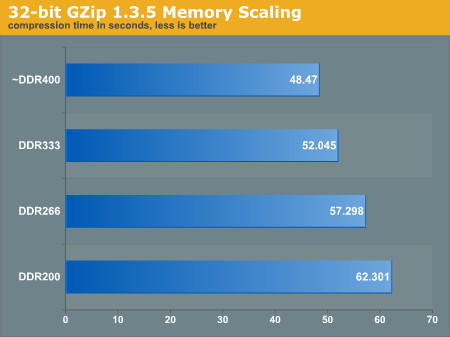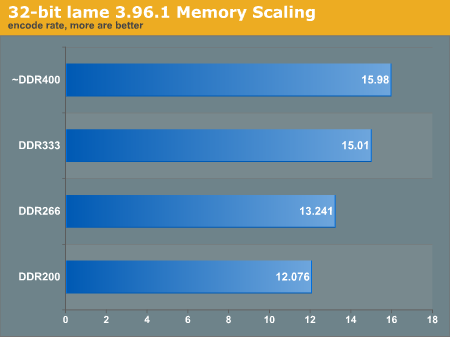Linux and the Desktop Pentium M: Uncommon Performance
by Kristopher Kubicki on December 24, 2004 12:00 PM EST- Posted in
- Linux
Memory Analysis
While testing the Pentium M on Linux, we came to the unofficial conclusion that Dothan was coming to a screeching halt on a lot of our benchmarks because it ran on antiquated DDR333. To put that theory to test, we took a few of the more memory intensive benchmarks and put the Dothan through its paces using different speeds of memory: DDR200, DDR266 and DDR333. To do these tests all on the same bus speed and multiplier, we had to tweak the memory ratio settings a bit, but fortunately, the motherboard was versatile enough to let us enable all of these modes. For this portion of the analysis, we are using the processor in a 100MHz bus with a 21X multiplier.

Now that we have proven the obvious (DDR333 is faster than DDR200), consider the implications of these benchmarks. Our DDR400 overclocking experiment should provide a very detailed outlay of what the sanctioned DDR400 platform will provide, even though the next generation Alviso chipset will also support DDR2 with different latencies.










47 Comments
View All Comments
Adul - Friday, December 24, 2004 - link
stephenbrooks "superlinearly" even a word? Though I do understand what you mean.KristopherKubicki - Friday, December 24, 2004 - link
abakshi: Intel roadmaps say only DDR1 for 915GL.Kristopher
stephenbrooks - Friday, December 24, 2004 - link
The Pentium M scales superlinearly with frequency in a few of the time vs. clock-speed benches (and I'm not talking about the 400->533 FSB improvement), which is pretty interesting. I wouldn't have expected a chip like this to get more efficient at _higher_ clocks.abakshi - Friday, December 24, 2004 - link
Well FSB533 is here, but 800 would be a more significant move with Dothan. A P-M with FSB800, even DDR400 let's say (rather than the DDR2 that should be supported by using a 915 northbridge), and higher clockspeeds - maybe about 2.4-2.6 Ghz - would be amazing.Linux performance will of course depend on other factors such as those mentioned in the article, but the performance under Windows of even the FSB400 2.0 Dothan is awesome -- when overclocked to 2.4Ghz, it's able to keep up with, and at times beat, the latest P4 Prescott and EE's, and A64's, for tasks like gaming:
http://www.gamepc.com/labs/view_content.asp?id=dot...
http://translate.google.com/translate?hl=en&sl...
Lonyo - Friday, December 24, 2004 - link
If Intel gave it a FSB and memory speed boost (ie: 533MHz or 800MHz FSB) and DDR533+, then Dothan could really be something.With Intels talk of dual core processors, a dual core Dothan, with its low heat output, would be awesome (but costly with 2MB of cache).
2x30w = 60w = less than Prescott.
It looks promising, if only Intel would bring it to the affordable desktop :(
VortigernRed - Friday, December 24, 2004 - link
"Although it holds up well against an Athlon 64 3200+,"Although the Dothan looks to be a superb chip you are certainly overstating its performance here, this is comment is WRT the Shake benchmarks and, effectively, the A64 3200 is twice as fast as the dothan. This would be like saying, for example, a R9800XT holds up well against an X800XT or an AXP2200+ holds up well against a A64 3800+ :-)
Also whilst the DDR400 does improve performance it can't help the Dothan where it is really far behind, the kernel compile benchmarks, for instance, it is still 3x slower than any of the other chips on the chart.
Dothan (or really its derivatives) have loads of potential to compete with the A64 on all fronts (Performance, power, heat, with Intels manufacturing, even cost) given enough effort by Intel (which I'm sure they are doing). I can hardly wait to see widespread adoption on the desktop and, frankly, to see the back of the P4. A desktop Celeron PM (1MB l2, lower FSB) could be the new overclocking king.
bersl2 - Friday, December 24, 2004 - link
You might want to ask on the GCC mailing lists (http://gcc.gnu.org/lists.html) about --march=pentium-m.